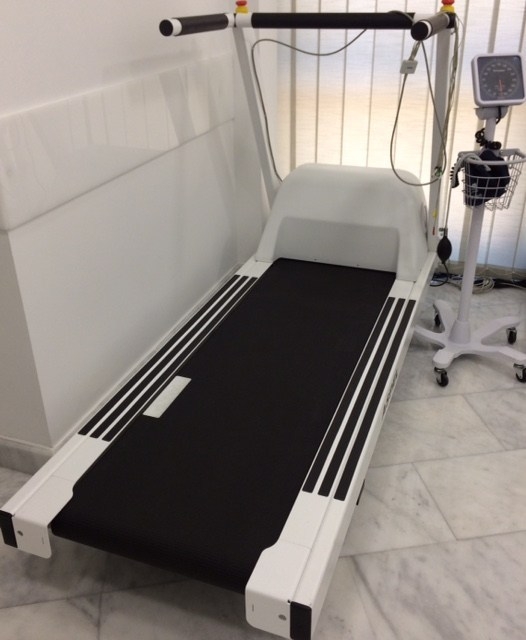Stress heart test

Fatigue test: What it will show you and what you need to know…
What do the results of the fatigue test show and what should be observed before the test?
The classic electrocardiographic (ECG) carpet fatigue test (fatigue test) is still a very useful diagnostic tool for the cardiologist, despite the rapid development of imaging methods for assessing coronary heart disease.
However, there is unclear information to patients regarding the indications and diagnostic sensitivity and specificity of the test in the detection and monitoring of coronary heart disease. Also very often doctors who refer patients for a fatigue test on the one hand have not investigated the ability of patients to walk on the ECG and on the other hand have not taken into account the pre-test probability that this patient has coronary heart disease.
The test has greater diagnostic value if performed in patients who have suspected symptoms for example: (chest pain when trying, angina) or in those who have risk factors (see: smoking, diabetes, hypertension, high cholesterol, family history, history of coronary heart disease). Young people are often referred for fatigue, without symptoms and without any risk factors, in these cases fatigue hasno diagnostic value and is not indicated.
In fact, in asymptomatic young patients without risk factors, even in the rare case that a sign of myocardial ischemia is detected on the ECG (positive test for ischemia) there is a high probability that a coronary angiography will be performed and the coronary arteries will be normal. . Often false-positive tests (for instance, the test is positive for ischemia while the coronary arteries do not show stenosis on coronary angiography) occur in women who complain of atypical atrial fibrillation.
For example, after the test, patients often ask "Did I made it, doctor?". But what do they mean and what should the doctor answer this question? The expression "Did I made it" generally does not make sense because each patient has a different level of fitness, and what is important for the diagnosis is to achieve the maximum predicted heart rate (maximum heart rate) for the age data. This maximum predicted heart rate is determined by the simple formula 220 minus age (for instance a 50-year-old patient has a maximum predicted heart rate of 220-50 = 170 which that means that when the pulse reaches 170 beats per minute the doctor has the right to stop test because it has obtained all the diagnostic information). However, many patients stop earlier because of severe muscle cramps (not in good physical condition) or because they show symptoms of chest pain or because they have dangerous arrhythmias or because the doctor detects signs of severe myocardial ischemia on the ECG.
In many cases the test is stopped due to a sudden and significant rise in blood pressure or vice versa sometimes due to a significant drop in blood pressure during exercise. In any case of interruption of the test due to patient exhaustion the test has diagnostic value as long as at least 85% of the maximum predicted heart rate has generally been achieved. Therefore, when the patient asks "if he made it", all the parameters that are taken into account during a fatigue test should be explained to him in a simplified way.
Patients often ask the doctor after the end of the test if "the test was good" and that’s where it should be explained to the patient that the outcome of a fatigue test, as well as whether he needs to do other tests afterwards. In many cases patients are confused by the expressions written by doctors in the test result, for example a positive test or a negative test. It should be clearly stated in the finding that the test is positive for ischemia (such as: there is a problem with myocardial ischemia on the ECG) or that the test is negative for ischemia (such as: there is no problem with myocardial ischemia on the ECG). Patients are often confused with the terms positive and negative, but in general the positive test for ischemia may need further testing while the negative test for ischemia probably does not need further testing. The need for further testing will be judged by the patient's cardiologist after being informed of the test result. It is self-evident that the result indicates the appearance or not, of severe arrhythmias and also the fluctuation of blood pressure during exercise.
The fatigue test has great diagnostic and clinical value in patients who have a known history of coronary heart disease, for example have a history of coronary artery bypass graft surgery (CABG) or a history of coronary angioplasty with stent placement. In these cases, the fatigue test is important. for long-term follow-up of these patients.
In any case, the cardiologist is responsible for referring you to a fatigue test and he or she should determine both the indication for the fatigue test and the information provided by the test result as formulated by the cardiologist who supervised the examination. The treating cardiologist will determine if the patient will need further screening with an ischemia-myocardial viability screening test (such as: thallium scintigraphy or dynamic dobutamine echocardiography) or if coronary angiography will be needed.It is very important that patients have been thoroughly examined by a cardiologist before undergoing a fatigue test in order to first avoid cases where the test is a contraindication and secondly to determine the likelihood of developing coronary heart disease (in those with no known history) based on risk factors and history.






